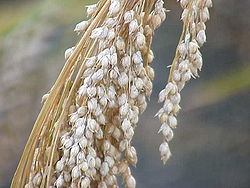| Panicum | |
|---|---|
 | |
| P. virgatum | |
| Scientific classification | |
| Kingdom: | Plantae |
| Clade: | Tracheophytes |
| Clade: | Angiosperms |
| Clade: | Monocots |
| Clade: | Commelinids |
| Order: | Poales |
| Family: | Poaceae |
| Subfamily: | Panicoideae |
| Supertribe: | Panicodae |
| Tribe: | Paniceae |
| Subtribe: | Panicinae |
| Genus: | Panicum L. |
| Synonyms [1] | |
| |
Panicum (panicgrass) [2] is a large genus of about 250 species of grasses mostly native to tropical regions.







